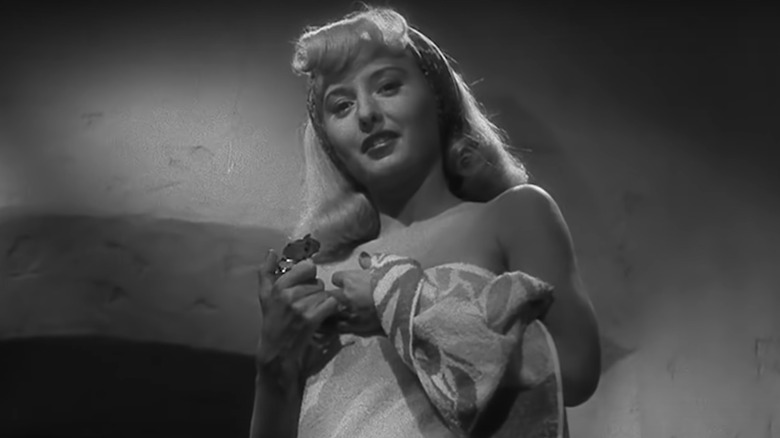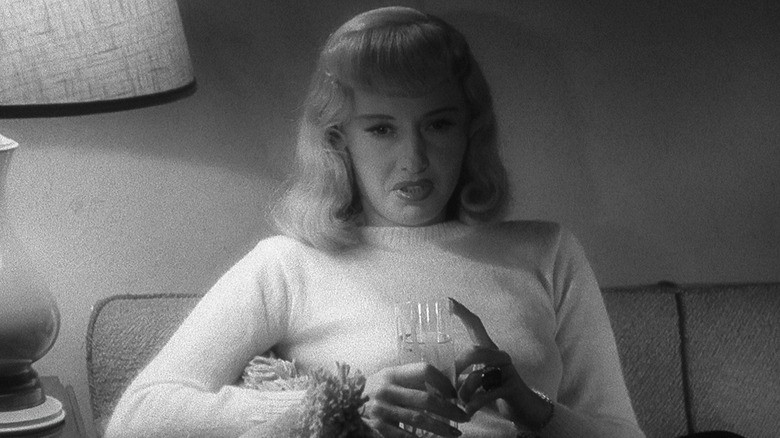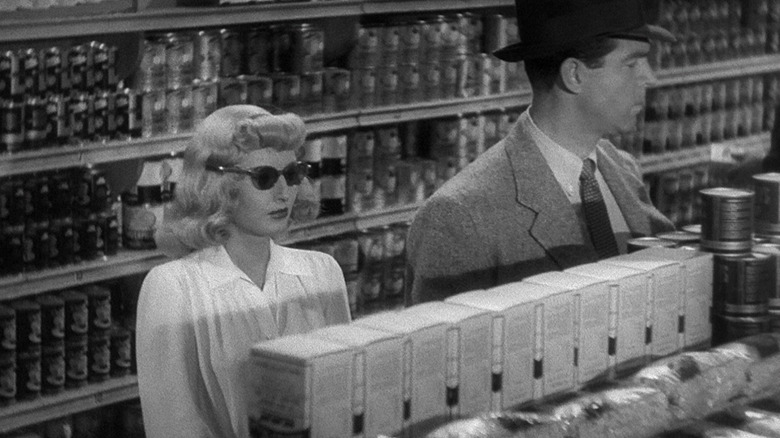The One Thing Billy Wilder Regrets The Most About Double Indemnity
We may receive a commission on purchases made from links.
If I was put on the spot to answer what the greatest film noir of all time is, I would unquestionably answer with "Double Indemnity." I would even go so far as to say it is one of the 25 greatest films ever made. Billy Wilder and Raymond Chandler's screenplay features a perfectly constructed crime story, building unrelenting suspense throughout the whole picture after telling you how it all goes down in the opening scene. Every character gets to rattle off reams of exquisite dialogue, and the cast, led by Fred MacMurray, Barbara Stanwyck, and Edward G. Robinson, attack each syllable with aplomb. John Seitz's gorgeous black and white cinematography commands shadows to make every image haunting and beautiful. This was Billy Wilder's third film as a director in Hollywood, and for my money, it is a perfect film.
Of course, no film is truly perfect. Perfection in art can't exist, because people do not approach art from the same perspectives. Common praises and criticisms may crossover between people, but no two perceptions are exactly the same. There is one element of "Double Indemnity" does tend to make people cock an eyebrow, and I'll admit that it sometimes even makes me cock one. I feel okay about questioning the choice because even Billy Wilder himself wishes he could have altered it before the film was finished. Unfortunately, Hollywood never gives you enough time and money, so he just had to endure it.
Why did Barbara Stanwyck wear that wig in Double Indemnity?
Barbara Stanwyck was already a big name by the time "Double Indemnity" came out. She had been a leading lady in Hollywood for over a decade and had garnered two Academy Award nominations for "Stella Dallas" and "Ball of Fire," one of the greatest romances ever made. She was an incredibly recognizable figure, and one thing people knew about Stanwyck was that she was a brunette. For the role of Phyllis Dietrichson, Wilder envisioned the character as a blonde. Now, Stanwyck had dyed her hair blonde for her role in "Stella Dallas," but for this film, the decision was made that she would wear a wig. And the wig is absolutely terrible. It doesn't sit right on her head at all, looks incredibly heavy, and features these absolutely ridiculous curls. In the book "Film Noir Reader 3: Interviews with the Filmmakers of the Classic Noir Period," Wilder speaks of his regret in choosing to put that wig on Stanwyck's head:
"But after the picture is half-finished, after I shot for four weeks with Stanwyck, now I know I made a mistake. I can't say, 'Look, tomorrow you ain't going to be wearing the blonde wig.' I'm stuck ... I can't reshoot four weeks of stuff. I'm totally stuck. I've committed myself; the mistake was caught too late. Fortunately it did not hurt the picture. But it was too thick, we were not very clever about wig-making."
Yes, the wig is not good, but Billy Wilder is right on the money with the second part of that remark. It really does not matter whether or not the quality of the wig is poor. Wilder goes on to say:
"But when people say, 'My god, that wig. It looked phony,' I answer, 'You noticed that? That was my intention. I wanted the phoniness in the girl, bad taste, phony wig.' That is how I get out of it."
Barbara Stanwyck's wig actually works for her character
While Billy Wilder's answer may have been given in jest, it actually does speak truthfully to how Phyllis is portrayed in "Double Indemnity." One of the all-time femme fatales, she's a schemer, looking to wrap people around her finger to do her bidding. She will take on any persona she sees fit if it gets her what she wants. The blonde makes her cold but alluring. The wig gives her this unnatural look that is alluring, which she needs to be in order to get Fred MacMurray's insurance salesman Walter Neff (two Fs, like in Philadelphia) to commit murder on her behalf.
Of course, had Barbara Stanwyck dyed her hair blonde for real for "Double Indemnity," maybe that allure would be amplified even more, making the film even more effective than it already is. Quite frankly, Stanwyck with her normal brunette hair is enchanting enough. I mean, in "Ball of Fire," she makes a house full of professors basically go insane from extreme horniness. Nevertheless, the wig is what we got, and we can all agree that it is not a very good piece of hairstyling.
Ultimately, "Double Indemnity" is an A+ masterpiece that has inspired filmmakers for decades upon decades. Neo-noirs, erotic thrillers, or any other crime story that features a central relationship follows in the footsteps of "Double Indemnity." Any femme fatale in a story will inevitably be compared to Stanwyck's Phyllis. The film is the gold standard for the genre and she for the archetype. If the film can manage all that with a terrible wig, there really is no use complaining about it.


